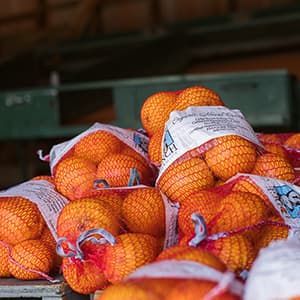
Nestled into rolling hills about an hour north of San Diego, California, Ray Lodge’s small farm has been growing some of the best citrus in the country for more than half a century.
“There’s history here,” Ray said. “The ranch was first established in 1862 with fruit trees and then cattle. My father’s family came in and planted orange trees in the 1960s.”
Today, those Valencia oranges are Ray’s primary crop – being sold whole or as juice in higher-end grocery stores.
While Ray’s oranges are usually in high demand, there is sometimes a surplus, or there are some perfectly good oranges that he can’t use. But, Ray makes sure they don’t go to waste. Years ago, a storm brought down a big percentage of his orange crop, so he donated them to a local social services center – but he needed volunteers from the center to come pick them up in order to haul them away.
These days, getting surplus oranges to people who need them is much easier.
Working with Feeding San Diego, Ray donates his extra produce to the food bank whenever possible – ensuring people facing hunger have access to the highest quality fruit, while also rescuing the food from being discarded.
“I text (the food bank) and within 24 hours, they’re here with a truck to pick up the produce and then it’s usually distributed in the community the day after that,” Ray said.
So far, Ray has donated nearly 6,000 pounds of premium produce to the food bank.
“It’s something I can give,” he said. “I don’t think in terms of dollars and cents, it’s just gratifying to be able to help out.”
For Feeding San Diego, working with farmers is a critical piece of the puzzle to provide healthy, local food to neighbors facing hunger. Last fiscal year, more than one-third of the food bank’s donations were from food growers or farmers in the area.
“Not every bit of produce is retail ready, so we jump in whenever we can to help the farmer make sure nothing goes to waste and redirect it to people facing hunger,” said Lety Rodriguez, sourcing manager at Feeding San Diego.
“Sourcing produce is really tough right now because of the drought. It’s either really expensive or unavailable. We are focusing on local first, because we can pick it up and we’re not paying the high transportation fees.”
Across the country, Feeding America works with farmers like Ray as well as manufacturers and retailers to help make sure food doesn’t go to waste. In fact, last year Feeding America rescued 3.6 billion pounds of food.
Back in the hills north of San Diego, Ray anticipates he’ll continue working with the food bank, even as farming as a whole has been challenging over the last few years.
“Farming isn’t an easy business,” Ray said. “I’m optimistic about the future, but there are terrific challenges, too. But, it’s a way of life. I couldn’t imagine doing anything else.”


